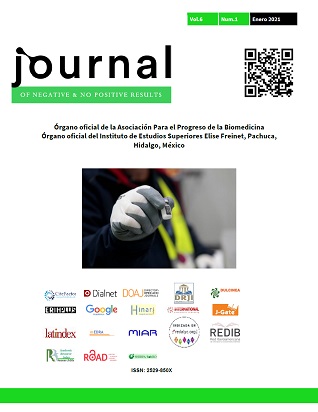Renin-angiotensin system (RAS) in cardiovascular pathologies: role on arterial hypertension
DOI:
https://doi.org/10.19230/jonnpr.3712Keywords:
Renin, Angiotensin, hypertension, inhibitorsAbstract
Introduction. In cardiovascular pathologies such as heart failure, arterial hypertension, vasculopathies, coronary diseases, etc; the renin-angiotensin system (RAS) has an essential role. The main actions include the regulation of blood pressure, vascular tone, volemia and facilitating sympathetic transmission.
Objective. This manuscript summarizes these aspects of the SRA and discussed the sequence of transformations of different proteins, beginning with the action of renin that transforms the angiotensinogen into angiotensin-I and later, it is converted into angiotensin II by the action of the Angiotensin-I converting enzyme (ACE-I).
Conclusions. When this system is altered culminates in hypertension, which can be controlled by pharmacological treatments using chemical inhibitors whose action mechanisms are based on preventing these enzymes from binding to their substrate and thus maintain a homeostatic balance in the pressure arterial.
Downloads
References
De la Serna, F. Novedades en el sistema renina-angiotensina. Insuficiencia Cardiaca, 2014; 9(1), 16-24.
Nawaz KAA, David SM, Murugesh E, Thandeeswaran M, GopikrishnanKiran K, Mahendran R. et al. Identification and in silico characterization of a novel peptide inhibitor of angiotensin converting enzyme from pigeon pea (Cajanus cajan). Phytomedicine, 2017, 9:13.
Ponce Y, Ponce A. El sistema Renina Angiotensina desde la circulaicón hasta la célula: implicaciones más allá de la hipertensión. CorSalud, 2012; 4(4):287-293.
Kotchen, T. Vasculopatía hipertensiva. In D. Longo, A. Fauci, D. Kasper, S. Hauser, J. Jameson & J. Loscalzo Eds., HARRISON Principios de medicina interna. New York, N.Y. USA: McGraw-Hill. 2012.
Ames MK, Atkins CE, Pitt B. The renin-angiotensin-aldosterone system and its suppression. J Vet Intern Med. 2019; 33:363–382.
Lima M, Nuccio J, Villalobos M, Balladares N. Sistema renina angiotensina y riesgo cardiometabólico. Rev. Venezolana Endocrin. Metab, 2010; 8(1):3-10.
Macaulay A, Nnonyelum T. Angiotensin converting enzyme inhibitors. In A. De Brue Ed., Angiotensin converting enzyme inhibitors. New York, NY, USA.: Nova Science Publishers, Inc. 2009.
Bader M. Tissue renin-angiotensin-aldosterone systems: targets for pharmacological therapy. Annu Rev Pharmacol Toxicol. 2010; 50(1): 439-465
Bustamante, G. Inhibidores de renina. Rev. Peruana Cardiol, 2008; 34(2): 129.
Aluko RE. Food protein-derived renin-inhibitory peptides: in vitro and in vivo properties. J Food Biochem. 2019; 43:12648.
Chen Y, Meng L, Shao H, Yu F. Aliskiren vs. other antihypertensive drugs in the treatment of hypertension: A meta-analysis. Hypertension Research, 2013; 36:252–261
Morales F, Estañ, L. Aliskiren: el primer inhibidor directo de la renina introducido en terapéutica. Rev Esp Cardiol Supl, 2009; 9:41A-48A
Bleakley S, Hayes M, O’Shea N, Gallagher E, Lafarga, T. Predicted release and analysis of novel ACE-I, renin, and DPP-IV inhibitory peptides from common oat (Avena sativa) protein hydrolysates using in silico analysis. Foods, 2017; 6:108
Domínguez M, Betancur D, Chel L. Caracterización de la ECA-I e inhibición con péptidos alimentarios. Alemania: Editorial Académica Española. 2012.
Guang C, Phillips RD, Jiang B, Milani F. Three key proteases-Angiotensin-I-converting enzyme (ACE), ACE2 and Renin- within and beyond the renin-angiotensin system. Arch. Cardiovasc. Dis. 2012; 105:373–385.
Yang Y, Tao G, Liu P, Liu J. Peptide with angiotensin I-converting enzyme inhibitory activity from hydrolyzed corn gluten meal. J. Agric. Food Chem, 2007; 55(19): 7891-7895
Published
Issue
Section
License
All accepted originals remain the property of JONNPR. In the event of publication, the authors exclusively transfer their rights of reproduction, distribution, translation and public communication (by any sound, audiovisual or electronic medium or format) of their work. To do so, the authors shall sign a letter transferring these rights when sending the paper via the online manuscript management system.
The articles published in the journal are freely used under the terms of the Creative Commons BY NC SA license, therefore.
You are free to:
Share — copy and redistribute the material in any medium or format
Adapt — remix, transform, and build upon the material
The licensor cannot revoke these freedoms as long as you follow the license terms.
Under the following terms:
Attribution — You must give appropriate credit, provide a link to the license, and indicate if changes were made. You may do so in any reasonable manner, but not in any way that suggests the licensor endorses you or your use.
NonCommercial — You may not use the material for commercial purposes.
ShareAlike — If you remix, transform, or build upon the material, you must distribute your contributions under the same license as the original.
No additional restrictions — You may not apply legal terms or technological measures that legally restrict others from doing anything the license permits.

This work is licensed under a Creative Commons Attribution-NonCommercial-ShareAlike 4.0 International License

























